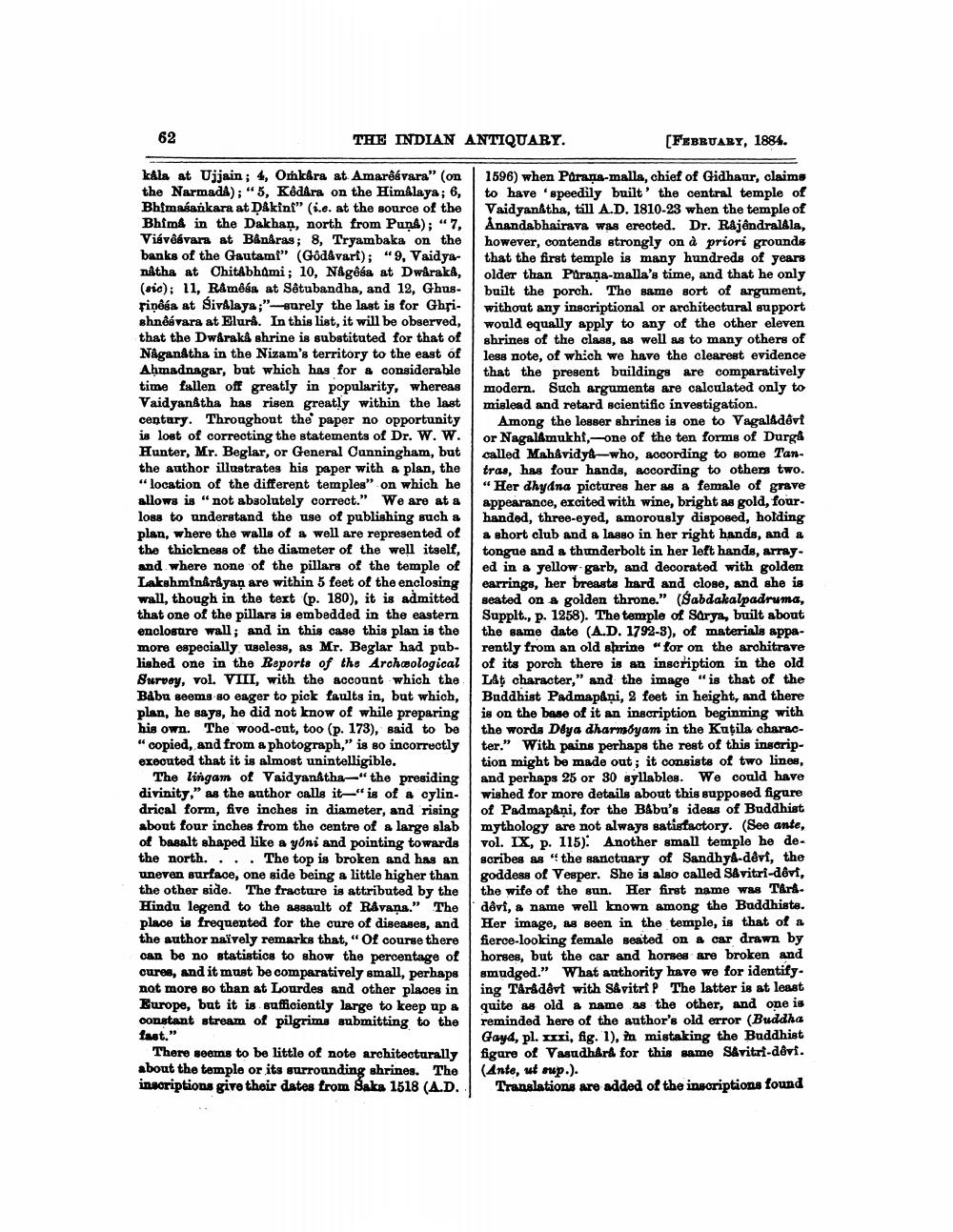________________
62
THE INDIAN ANTIQUARY.
kala at Ujjain; 4, Omkåra at Amarêsvara" (on the Narmada); "5, Kêdêra on the Himalaya; 6, Bhimasankara at Dâkinf" (i.e. at the source of the Bhims in the Dakhan, north from Puns); "7, Visvesvara at Bânâras; 8, Tryambaka on the banks of the Gautam!" (Godavari); "9, Vaidyanatha at Chitâbhami; 10, Någêéa at Dwaraka, (sic); 11, Râmêsa at Sêtubandha, and 12, Ghusrinêéa at Śivalaya;"-surely the last is for Ghrishnêsvara at Elurs. In this list, it will be observed, that the Dwarakâ shrine is substituted for that of Någanatha in the Nizam's territory to the east of Ahmadnagar, but which has for a considerable time fallen off greatly in popularity, whereas Vaidyanatha has risen greatly within the last century. Throughout the paper no opportunity is lost of correcting the statements of Dr. W. W. Hunter, Mr. Beglar, or General Cunningham, but the author illustrates his paper with a plan, the "location of the different temples" on which he allows is "not absolutely correct." We are at a loss to understand the use of publishing such a plan, where the walls of a well are represented of the thickness of the diameter of the well itself, and where none of the pillars of the temple of Lakshminarayan are within 5 feet of the enclosing wall, though in the text (p. 180), it is admitted that one of the pillars is embedded in the eastern enclosure wall; and in this case this plan is the more especially useless, as Mr. Beglar had published one in the Reports of the Archaeological Survey, vol. VIII, with the account which the. Babu seems so eager to pick faults in, but which, plan, he says, he did not know of while preparing his own. The wood-cut, too (p. 173), said to be copied, and from a photograph," is so incorrectly executed that it is almost unintelligible.
The lingam of Vaidyanatha-"the presiding divinity," as the author calls it "is of a cylindrical form, five inches in diameter, and rising about four inches from the centre of a large slab of basalt shaped like a yoni and pointing towards the north.... The top is broken and has an uneven surface, one side being a little higher than the other side. The fracture is attributed by the Hindu legend to the assault of Ravana." The place is frequented for the cure of diseases, and the author naïvely remarks that, "Of course there can be no statistics to show the percentage of cures, and it must be comparatively small, perhaps not more so than at Lourdes and other places in Europe, but it is sufficiently large to keep up a constant stream of pilgrims submitting to the
fast."
There seems to be little of note architecturally about the temple or its surrounding shrines. The inscriptions give their dates from Saka 1518 (A.D.
[FEBRUARY, 1884.
1596) when Parana-malla, chief of Gidhaur, claims to have speedily built the central temple of Vaidyanatha, till A.D. 1810-23 when the temple of Anandabhairava was erected. Dr. Rajendralala, however, contends strongly on à priori grounds that the first temple is many hundreds of years older than Parana-malla's time, and that he only built the porch. The same sort of argument, without any inscriptional or architectural support would equally apply to any of the other eleven shrines of the class, as well as to many others of less note, of which we have the clearest evidence that the present buildings are comparatively modern. Such arguments are calculated only to mislead and retard scientific investigation.
Among the lesser shrines is one to Vagaladevi or Nagalamukhi,-one of the ten forms of Durgå called Mahavidya-who, according to some Tantras, has four hands, according to others two. "Her dhydna pictures her as a female of grave appearance, excited with wine, bright as gold, fourhanded, three-eyed, amorously disposed, holding a short club and a lasso in her right hands, and a tongue and a thunderbolt in her left hands, arrayed in a yellow garb, and decorated with golden earrings, her breasts hard and close, and she is seated on a golden throne." (Sabdakalpadruma, Supplt., p. 1258). The temple of Sarya, built about the same date (A.D. 1792-5), of materials apparently from an old shrine "for on the architrave of its porch there is an inscription in the old Lât character," and the image "is that of the Buddhist Padmapâni, 2 feet in height, and there is on the base of it an inscription beginning with the words Déya dharmoyam in the Kutila character." With pains perhaps the rest of this inscription might be made out; it consists of two lines, and perhaps 25 or 30 syllables. We could have wished for more details about this supposed figure of Padmapâni, for the Babu's ideas of Buddhist mythology are not always satisfactory. (See ante, vol. IX, p. 115): Another small temple he describes as "the sanctuary of Sandhya-dêvi, the goddess of Vesper. She is also called Savitri-dêvi, the wife of the sun. Her first name was Târâdêvî, a name well known among the Buddhists. Her image, as seen in the temple, is that of a fierce-looking female seated on a car drawn by horses, but the car and horses are broken and smudged." What authority have we for identifying Târâdêvt with Savitri ? The latter is at least quite as old a name as the other, and one is reminded here of the author's old error (Buddha Gayd, pl. xxxi, fig. 1), in mistaking the Buddhist figure of Vasudhårå for this same Savitri-dêvî. (Ante, ut sup.).
Translations are added of the inscriptions found




